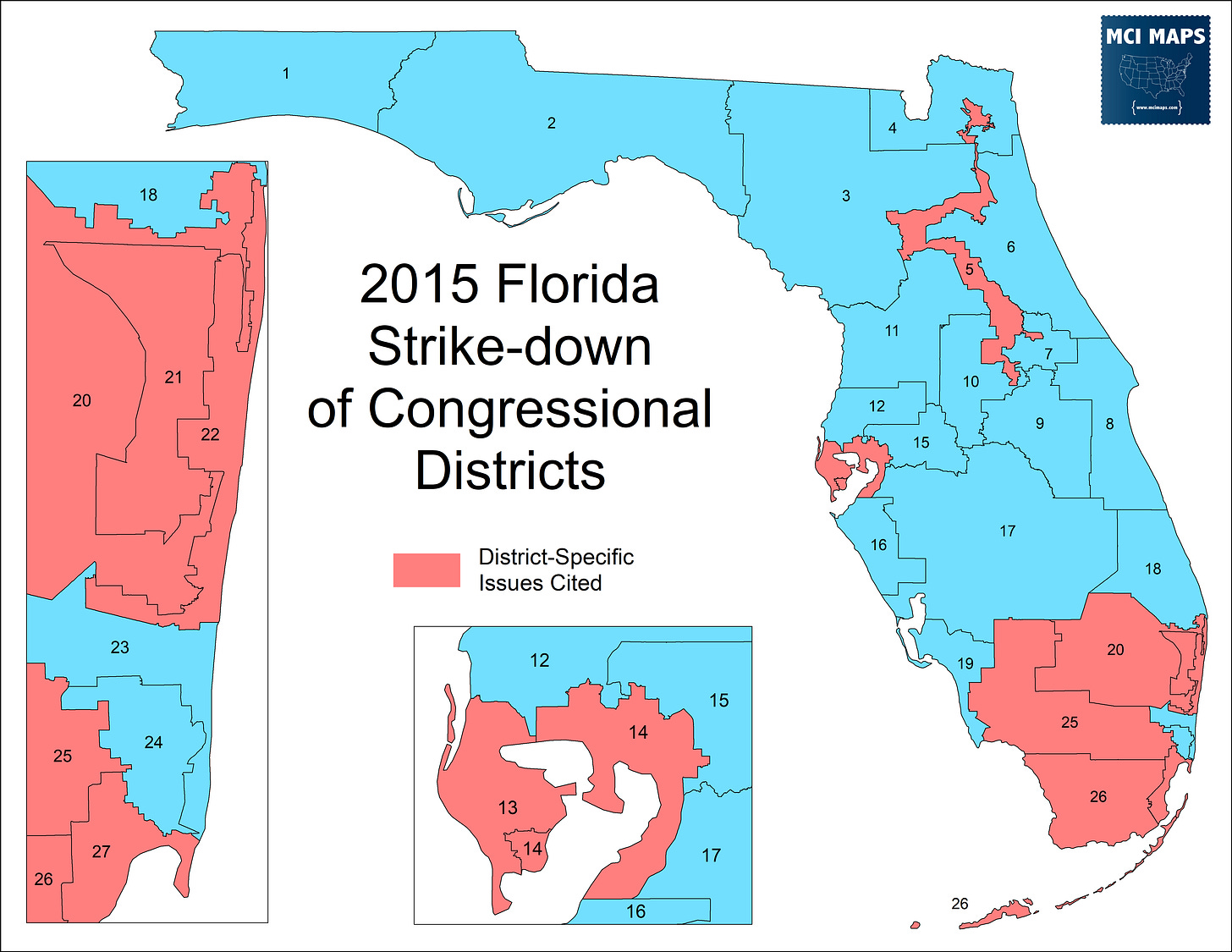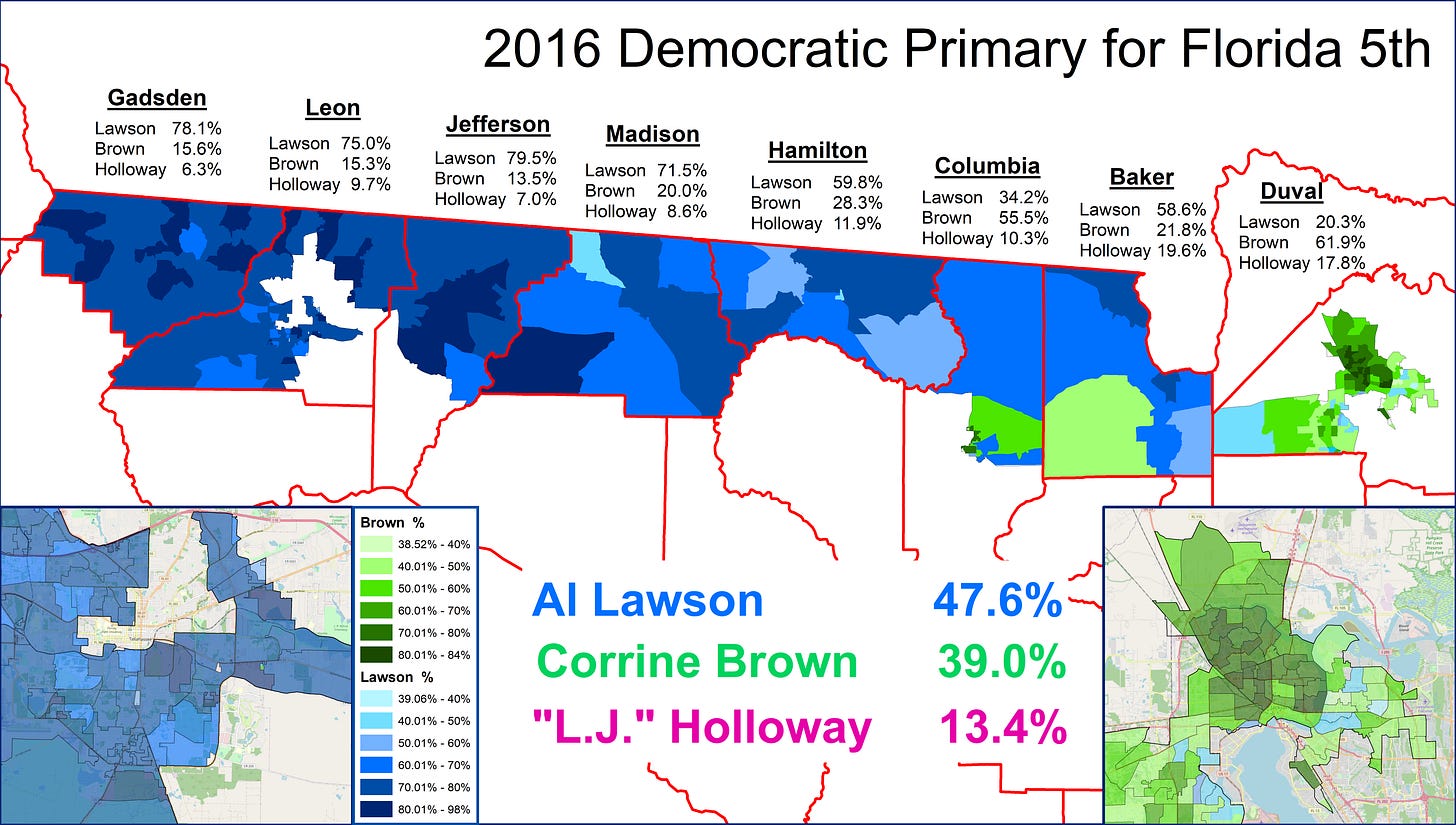On Monday, qualifying in Florida began. I tweeted, rather prophetically, that last minute moves can and do happen during qualifying. In the last four days (and this post will go out mere hours before the deadline) many games of musical chairs and last-minute candidacies have taken place. This substack post will focus on just one district, for the moves there have been by far the most dramatic. In Florida’s Orando-based 10th Congressional district, former Congressman Alan Grayson, and former Congresswoman Corrine Brown, have filed for the district. They join State Senator Randolph Bracy and activists Maxwell Frost in what is now a race between 4 prominent candidates.
Easily two the of the most controversial members of Florida democratic delegation in recent decades, their entry upends the race, and caused many democrats (like myself) to groan in pure agony. So lets talk about this
The New 10th Congressional District
If you have been following my redistricting coverage, you have seen me talk about the 10th district plenty of times. The new district, located in the heart of Orange County, is a deep-blue district with a racially diverse Democratic primary. The district’s democratic primary, which is tantamount to election, is around 40% white, 35% black, and 15% Hispanic.
These lines, however, crack black voters in Orlando, dividing them between two districts.
The reason for this configuration is part of Ron DeSantis’ racial and partisan gerrymander of the state’s Congressional lines. The district stretches across Orlando to grab Democratic-leaning white and Hispanic voters; aiming to make the 10th a Democratic vote-sink. In doing so, the district is 5 points more white than black; even though other draft maps showed a plurality-black district could be drawn. Earlier drafts matched closer to the current 10th, which is around 45-50% black in a democratic primary.
So this district is a byproduct of racial gerrymandering. A vote-sink that still splits black voters. For the last several months, two candidates strong have been campaigning for the seat. State Senator Randolph Bracy and activist Maxwell Frost. Both candidates are black, with Bracy representing more of the establishment/liberal wing of the party, while Frost is a young progressive.
For months, Democratic activists, including myself, called on other non-black candidates to stay out of the primary. Why? Because DeSantis’ racially gerrymander already reduced the number of black-performing seats from 4 to 2 (the South Florida 20th and 24th remain). While the 10th’s status as a black-performing seat was weakened, it was still an access seat. Since Frost and Bracy had already been campaigning for the seat; which was being vacated by Val Demings, while it was originally a stronger black-performing seat, a white Democrat getting in due to the changes would be - well, shitty. Like, do you really want to take advantage of DeSantis’ gerrymander? There were, rightfully, massive protests to the new Congressional map from black leaders. It becomes an issue of solidarity.
Well one person clearly knows nothing about solidarity. That man is Alan Grayson
Alan Grayson’s Candidacy
Alan Grayson’s entry into the race is especially egregious due to what I discussed above. It is hard not believe he thinks his opening is that the black vote is going to be divided. Grayson also likely sees support within the district. He represented the area, with some overlap of the new district, and has been a high-profile candidate in the area for over a decade.
Grayson originally won FL-08 in 2008, taking the seat in the blue wave. However, in 2010, he lost to now-Congressman Dan Webster, losing by 20 points, greatly underperforming Dem Gubernatorial Candidate Alex Sink.
Grayson was a bold progressive, and generated positive headlines for his line on the House floor that the GOP healthcare plan was to “don’t get sick, but if you do, die quickly.” Grayson lost support, however, when he compared the healthcare industry to a modern Holocaust, drawing widespread condemnation. Grayson, amid his re-election, then ran ads that edited Webster videos to imply he said wives should be subservient to their husbands; and decreed he was an American Taliban. This killed his reputation as a serious candidate.
Two years later, however, Grayson would return to Congress after the 2012 redistricting process. Republicans, bound by the newly-passed Fair Districts, drew several new Democratic-leaning seats. They still gerrymandered where they could, which would eventually be discovered and lead to the 2015 strike-down. In the meantime, however, Republicans made no efforts to avoid drawing the 9th district as an Hispanic-access seat; reflecting the rapidly growing Puerto Rican population in the area.
Grayson announced his candidacy for the 9th. The seat was still majority white in voting, and Grayson was able to easily secure the seat. Rumors of bullying and threats against local democrats to let him have the seat; with threats of using his fortune or vast fundraising network to short-circuit any threats. Grayson would easily take the Democrat-heavy 9th, part of several democratic pickups that year.
Grayson would then make a play for US Senate in 2016. National Democrats recruited moderate Democrat Patrick Murphy, who represented the Romney-voting 18th, to run. Grayson flat out declared he would not back Murphy if he lost the primary, and engaged in a nasty campaign. His efforts faltered, however, when accusations of abuse from his ex-wife came to light. Grayson crashed in the polls and only got 18% of the vote.
While Grayson did not do well statewide, he still maintained modest support in the area he represented for the last several years. He won what is now the new 10th district. In the new 10th, Grayson got 40% to Murphy’s 39%.
Now, to be clear, Grayson’s support from 2016 does not translate to guaranteed support now. For one, many of Grayson’s best precincts were largely in the black-majority western end of the district. Its easy to imagine that support will fade.
In 2018, Grayson tried to reclaim his Congressional seat. In 2016, Hispanic State Senator Darren Soto won the seat. One of the candidates Soto defeated was Grayson’s girlfriend-then-wife (they married during the campaign). Whole Soto won, Grayson had won the redrawn-9th (remember that 2016 redistricting) by 3 points; doing best in the Hispanic precincts of Osceola. In the race against Soto, Grayson tanked. He only got 34% of the vote, and lost those Hispanic communities.
Grayson’s different support bases between the two elections further highlight that the 2016 showing in 10 isn’t entirely predictive. Grayson would likely need to consolidate the white and Hispanic east-end of the district, not the west.
Grayson’s latest entry is part of a long pattern of selfish behavior. Grayson only cares about one person, himself.
Corrine Brown’s Candidacy
The entry of Brown into this contest is another insane twist. It is especially telling because the former Congresswoman has been opposed to a version of this district existing for years. For those of you who read my redistricting history articles, you will known Brown has a long history in Florida’s redistricting drama. In the 1990s, she was part of a group of black lawmakers who aimed to ensure minority districts were drawn. The 1990s redistricting process is incredibly complicated; and I recommend refreshing yourself with this breakdown. The clash between the Voting Rights Act and personal ambition led to some crazy lines. That said, the push for minority districts was justified; aimed at reversing decades of cracking and Jim Crow. Brown would go on to win a black-access district based around North Florida.
The district was later modified by the courts and eventually took a general form of going from Jacksonville to Orlando. Brown faced no tough elections after 1994. By 2012, demographic change indicated a black-performing district could be drawn just in North Florida, leaving open the possibility of a black-access, or minority coalition, seat in Orlando. Brown, however, was a fierce opponent of any changes to her district. By the post 2012 era, it was clear Brown resisted change purely for her own reasons. She’d built a political power base in Jacksonville and across the district and resisted any changes. In 2015, when the Florida Supreme Court struck down the Jacksonville-Orlando district, claiming it was a political gerrymander that packed Democrats in Orlando, Brown lost her shit.
Brown hated the court order to make the 5th district go east-west. The new district would united the black communities of North Florida that traced their history to the plantations. This is something I’ve written about extensively in my history on the 5th district. Article here.
Brown claimed, incorrectly, the new 5th was not truly a black-performing seat. She said the black % was inflated by prisons, and that the seat was actually a GOP district. This was countered by election data. Brown, however, never let facts get in her way. Brown lost every court case she filed, and finally faced a primary from former Tallahassee State Senator Al Lawson. Then, just months before the primary, Brown was indicted for fraud. The charges revolved around a fake charity (details in link). Brown’s corruption was never much of a secret, but this was damning. In the end, she lost the primary to Lawson. She got destroyed in the wester counties; and posted an anemic 60% in her longtime Jacksonville power base.
Brown would eventually be tried, was convicted, and went to prison for several years. Her conviction was overturned due to improper removal of a juror. Instead of a new trial, Brown agreed to plead guilty to tax fraud and pay over $60,000 in restitution.
And now she is running for Congress - mere weeks after the plea.
Looking Ahead
This race may very well be the most high profile democratic primary in Florida this year. Honestly the Gubernatorial primary doesn’t seem nearly as exciting as this now. We have two candidates who have been running for months; a local senator and well-known activists. Now, two failed former politicians have parachuted in, trying to reclaim glory. The contrast is stark.
Frost is the only candidate without a political base from a district. He does have a great deal of national progressive back, however. Brown and Bracy have a great deal of overlap between the former 5th and Bracy’s state senate seat. Grayson. meanwhile, represented a good chunk of Hispanic and diverse precincts in the east end.
And with no runoffs, its whoever can get the most votes.
Please, by all that is holy, don’t let it be Grayson or Brown.













